United States
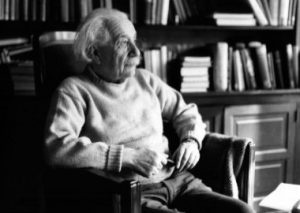 For many years, I have admired Albert Einstein. His mind and his level of intelligence intrigued me, as did his quirkiness. When you think of a genius, your mind automatically produces a picture of a very organized person, who is able to handle any situation, but even geniuses have their issues with things. One well know “weakness” for Einstein was the fact that if something can be written down, it need not take up space in his brain. His brain was very full after all, and clutter was always an issue. That said, if he couldn’t find his train ticket…for the train he took every day from home to work and back…he didn’t know at which stop to get off, because he relied on his ticket to tell him that. I don’t think most of us could even begin to filter our brain in such a way…but Einstein could, and did.
For many years, I have admired Albert Einstein. His mind and his level of intelligence intrigued me, as did his quirkiness. When you think of a genius, your mind automatically produces a picture of a very organized person, who is able to handle any situation, but even geniuses have their issues with things. One well know “weakness” for Einstein was the fact that if something can be written down, it need not take up space in his brain. His brain was very full after all, and clutter was always an issue. That said, if he couldn’t find his train ticket…for the train he took every day from home to work and back…he didn’t know at which stop to get off, because he relied on his ticket to tell him that. I don’t think most of us could even begin to filter our brain in such a way…but Einstein could, and did.
Einstein was a gifted scientist and mathematician. He was most famous for his theory of relativity and the resulting formula relating mass and energy…E = MC². He was the winner of 1921 Nobel Prize in physics for his work on the photoelectric effect, which is also known as the Hertz effect. Einstein was born in Ulm, in the Kingdom of Württemberg in the German Empire, on March 14, 1879. His parents were Hermann Einstein, a salesman and engineer, and Pauline Koch. He didn’t feel the need to celebrate his birthday,saying “It is a known fact that I was born, and that is all that is necessary.” Friends, colleagues and complete strangers still felt the need to send telegrams, cards, letters, gifts, and an elaborate birthday cake.
Being a Jewish man, circumstances in Germany became life threatening for Einstein in the early 1930s, so early in 1933, while on a trip to the United States, he knew he could not go home again, so he moved permanently 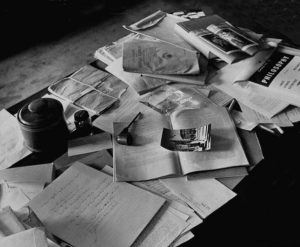 to the United States, and worked at Princeton University…a career that would take him to the end of his life on April 18, 1955. Einstein could have been saved, but when he was asked if he wanted to undergo surgery, he refused, saying, “I want to go when I want to go. It is tasteless to prolong life artificially. I have done my share; it is time to go. I will do it elegantly.” After an autopsy, Einstein’s body was cremated and his ashes spread in an undisclosed location.
to the United States, and worked at Princeton University…a career that would take him to the end of his life on April 18, 1955. Einstein could have been saved, but when he was asked if he wanted to undergo surgery, he refused, saying, “I want to go when I want to go. It is tasteless to prolong life artificially. I have done my share; it is time to go. I will do it elegantly.” After an autopsy, Einstein’s body was cremated and his ashes spread in an undisclosed location.
After his passing, another of the multiple quirky aspects of Einstein’s personality came to light when LIFE magazine wrote about a famous picture taken in Albert Einstein’s Princeton office. Einstein’s desk was just as he left it. Here, the picture says, is where Einstein worked, dreamed, lived his singular, principled life to its fullest. “When I was young, all I wanted and expected from life was to sit quietly in some corner doing my work without the public paying attention to me,” said Einstein after being honored at a social function. “And now see what has become of me.”
When I look and Einstein’s desk, it takes me back to the many times my own desk has looked exactly like that. It is another way that the famed scientific and mathematical genius and I are alike. Now, I do not claim to have the IQ of this man, but we do have a few things in common, and the ability to work on top of a stack of papers seems to be one of them. Maybe that and the ability to somewhat filter things out of my mind if they are stored in my phone which could be the same thing as filtering because I have it written down. And because of my shy side, I suppose I can understand his concern over public attention, and yet knowing that sometimes it can’t be helped. When I look at his desk, I can see a man whose mind was fill with many thoughts, making it easy to 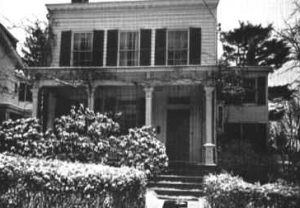 lose himself in his thoughts to the point of seeming to ignore those around him. Those who met Einstein recalled his human side. He “walked to work or rode the bus in bad weather; visited the neighbors’ newborn kittens; greeted carolers on winter nights; refused to update his eyeglass prescription; and declined to wear socks because they would get holes in them. But he didn’t seem to mind fuzzy slippers!” He was his own man with his own ideas, and if those ideas didn’t make sense to those around him, it was simply not his problem. On April 18, 1955, Albert Einstein died soon after a blood vessel burst near his heart. The world mourned Einstein’s death, but true to form, at his request, his office and house were not turned into memorials.
lose himself in his thoughts to the point of seeming to ignore those around him. Those who met Einstein recalled his human side. He “walked to work or rode the bus in bad weather; visited the neighbors’ newborn kittens; greeted carolers on winter nights; refused to update his eyeglass prescription; and declined to wear socks because they would get holes in them. But he didn’t seem to mind fuzzy slippers!” He was his own man with his own ideas, and if those ideas didn’t make sense to those around him, it was simply not his problem. On April 18, 1955, Albert Einstein died soon after a blood vessel burst near his heart. The world mourned Einstein’s death, but true to form, at his request, his office and house were not turned into memorials.
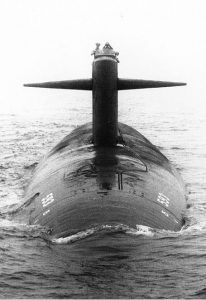 With new technology, always comes some risk of failure. Sometimes, the the failure doesn’t hurt anything, but other times, it can be deadly. In the world of submarines, the atomic submarine was the latest thing in the 1960s. The USS Thresher was launched on July 9, 1960, from Portsmouth Naval Yard in New Hampshire. It was built with the latest technology, and was the first submarine assembled as part of a new class that could run more quietly and dive deeper than any that had come before it. The designers and the Navy expected great things from Thresher, and initially, the submarine met their expectations.
With new technology, always comes some risk of failure. Sometimes, the the failure doesn’t hurt anything, but other times, it can be deadly. In the world of submarines, the atomic submarine was the latest thing in the 1960s. The USS Thresher was launched on July 9, 1960, from Portsmouth Naval Yard in New Hampshire. It was built with the latest technology, and was the first submarine assembled as part of a new class that could run more quietly and dive deeper than any that had come before it. The designers and the Navy expected great things from Thresher, and initially, the submarine met their expectations.
Then on April 10, 1963, at just before 8am, the Thresher was conducting drills off the coast of Cape Cod. At 9:13am, the USS Skylark, another ship participating in the drills, received a communication from the Thresher that the sub was experiencing 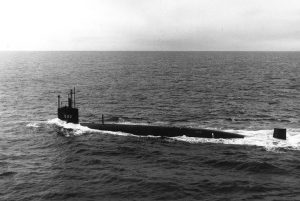 minor problems. Unfortunately, the minor problems turned into a very major problem…almost instantly. Other attempted communications with Thresher failed and, only five minutes later, sonar images showed the Thresher breaking apart as it fell to the bottom of the sea, 300 miles off the coast of New England. Sixteen officers, 96 sailors and 17 civilians were on board. All were killed.
minor problems. Unfortunately, the minor problems turned into a very major problem…almost instantly. Other attempted communications with Thresher failed and, only five minutes later, sonar images showed the Thresher breaking apart as it fell to the bottom of the sea, 300 miles off the coast of New England. Sixteen officers, 96 sailors and 17 civilians were on board. All were killed.
On April 12, President John F. Kennedy ordered that flags across the country be flown at half-staff to commemorate the lives lost in this disaster. A subsequent investigation revealed that a leak in a silver-brazed joint in the engine room had caused a short circuit in critical electrical systems. The problems quickly spread, making the equipment needed to bring the Thresher to the surface inoperable. The submarine went into a freefall to the bottom. There was no time to do anything to stop it or find a way of escape…if one existed.
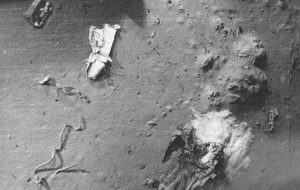
The disaster forced improvements in the design and quality control of submarines. Twenty-five years later, in 1988, Vice Admiral Bruce Demars, the Navy’s chief submarine officer, said “The loss of Thresher initiated fundamental changes in the way we do business–changes in design, construction, inspections, safety checks, tests, and more. We have not forgotten the lessons learned. It’s a much safer submarine force today.” I don’t think there was necessarily anything that was done so wrong that it could have prevented what happened, but I could be wrong. Obviously, there is always room for improvement in any design, but unfortunately, sometimes the only way to know that an improvement is needed, is to have a disaster strike.
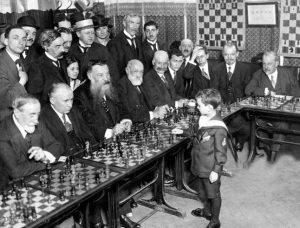 Mastery knows no age. Genius can occur in anyone, and of course, always presents itself when a child is very young. In 1920, one such genius, Samuel Reshevsky was busy mastering chess masters in France. Reshevsky learned chess when he was just 4 years old. He became known as a child chess prodigy and was playing simultaneous games of chess against adults when he was 6 years of age. At age 8 he was playing chess against strong players. Following the events of World War 1, Reshevsky immigrated to the United States. As a 9 year old, his first American simultaneous exhibition was with 20 officers and cadets at the Military Academy at West Point. He won 19 games and drew one. He toured the country and played over 1,500 games as a 9 year old in simultaneous exhibitions and only lost 8 games. In his early years he did not go to school and his parents ended up in Manhattan Children’s Court on charges of improper guardianship. In reality, little Samuel probably could have taught the teachers, so missing some of his education was not detrimental to him in any way.
Mastery knows no age. Genius can occur in anyone, and of course, always presents itself when a child is very young. In 1920, one such genius, Samuel Reshevsky was busy mastering chess masters in France. Reshevsky learned chess when he was just 4 years old. He became known as a child chess prodigy and was playing simultaneous games of chess against adults when he was 6 years of age. At age 8 he was playing chess against strong players. Following the events of World War 1, Reshevsky immigrated to the United States. As a 9 year old, his first American simultaneous exhibition was with 20 officers and cadets at the Military Academy at West Point. He won 19 games and drew one. He toured the country and played over 1,500 games as a 9 year old in simultaneous exhibitions and only lost 8 games. In his early years he did not go to school and his parents ended up in Manhattan Children’s Court on charges of improper guardianship. In reality, little Samuel probably could have taught the teachers, so missing some of his education was not detrimental to him in any way.
Reshevsky was a tough and forceful player who was superb at positional play, but could also play brilliant 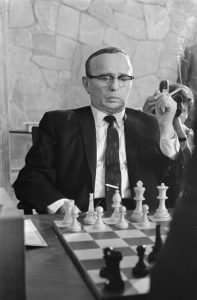 tactical chess when warranted. He often used huge amounts of time in the opening, a dangerous tactic which sometimes forced him to play the rest of the game in a very short amount of time. That sometimes unsettled Reshevsky’s opponents, but at other times resulted in blunders on his part. Reshevsky’s inadequate study of the opening and his related tendency to fall into time-pressure may have been the reasons that, despite his great talent, he never became world champion; he himself acknowledged this in his book on chess upsets.
tactical chess when warranted. He often used huge amounts of time in the opening, a dangerous tactic which sometimes forced him to play the rest of the game in a very short amount of time. That sometimes unsettled Reshevsky’s opponents, but at other times resulted in blunders on his part. Reshevsky’s inadequate study of the opening and his related tendency to fall into time-pressure may have been the reasons that, despite his great talent, he never became world champion; he himself acknowledged this in his book on chess upsets.
Reshevsky never became a truly professional chess player. He gave up competitive chess for seven years, from 1924 to 1931, to complete his secondary education. He graduated from the University of Chicago in 1934 with a degree in accounting, and supported himself and his family by working as an accountant. Not everyone could leave off and then pick up their education and never miss a beat. Of course, when you have genius level intelligence, I guess that isn’t a problem.
 During the Vietnam War, as in any war, children can become displaced because of the loss of their parents. The country has already lost so many people, and often there is no one to take these little orphans, so they often end up in an orphanage, waiting for someone to come along and adopt them. Many times, they live their entire childhood in that orphanage. For a country that has already be devastated by war, the cost of raising these children is detrimental. Such was the case for orphaned children from the Vietnam War. Then the United States made the decision to airlift these children to the United States to be adopted by American families who were waiting for children. The plan was dubbed Operation Baby Lift, and while it would end up being successful, it got of the a sad and rocky start on April 4, 1975, when the first plane crashed shortly after taking off from Tan Son Nhut airbase in Saigon. On board were more than 300 passengers. Of those, 138 passengers, mostly children were killed.
During the Vietnam War, as in any war, children can become displaced because of the loss of their parents. The country has already lost so many people, and often there is no one to take these little orphans, so they often end up in an orphanage, waiting for someone to come along and adopt them. Many times, they live their entire childhood in that orphanage. For a country that has already be devastated by war, the cost of raising these children is detrimental. Such was the case for orphaned children from the Vietnam War. Then the United States made the decision to airlift these children to the United States to be adopted by American families who were waiting for children. The plan was dubbed Operation Baby Lift, and while it would end up being successful, it got of the a sad and rocky start on April 4, 1975, when the first plane crashed shortly after taking off from Tan Son Nhut airbase in Saigon. On board were more than 300 passengers. Of those, 138 passengers, mostly children were killed.
Captain Dennis “Bud” Traynor was the captain on the plane. Many of the 138 passengers were children, and 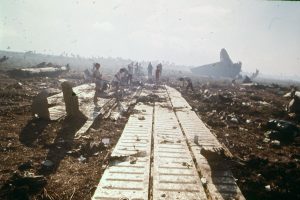 many of them were under age 2 and so small, they had to be carried onto the plane. “We bucket-brigade-loaded the children right up the stairs into the airplane,” Traynor remembers. The flight began normally, but shortly into the flight, when the plane’s cargo doors malfunctioned they blew out, taking with them a chunk of the tail. There was a rapid decompression inside the aircraft, causing the pilot, Traynor, to crash land the C-5 cargo plane into a nearby rice paddy. Traynor managed to stabilize the plane and turn it back toward Vietnam. After that, his only option was a crash landing. The impact was fierce. “It cut all control cables to the tail,” explains Traynor. “So I’m pulling and pulling and pulling, and my nose is going down further and further and we’re going faster and faster and faster, and I can’t figure this out. We came to a stop and I thought to myself ‘I’m alive,'” he says. “And so I undid my lap belt, fell to the ceiling, rolled open the side window, and stepped out and saw the wings burning. And I thought, ‘Oh no, that’s the rest of the airplane.'” Out of the more than 300 people on board, the death toll included 78 children and about 50 adults, including Air Force personnel. More than 170 survived.
many of them were under age 2 and so small, they had to be carried onto the plane. “We bucket-brigade-loaded the children right up the stairs into the airplane,” Traynor remembers. The flight began normally, but shortly into the flight, when the plane’s cargo doors malfunctioned they blew out, taking with them a chunk of the tail. There was a rapid decompression inside the aircraft, causing the pilot, Traynor, to crash land the C-5 cargo plane into a nearby rice paddy. Traynor managed to stabilize the plane and turn it back toward Vietnam. After that, his only option was a crash landing. The impact was fierce. “It cut all control cables to the tail,” explains Traynor. “So I’m pulling and pulling and pulling, and my nose is going down further and further and we’re going faster and faster and faster, and I can’t figure this out. We came to a stop and I thought to myself ‘I’m alive,'” he says. “And so I undid my lap belt, fell to the ceiling, rolled open the side window, and stepped out and saw the wings burning. And I thought, ‘Oh no, that’s the rest of the airplane.'” Out of the more than 300 people on board, the death toll included 78 children and about 50 adults, including Air Force personnel. More than 170 survived.
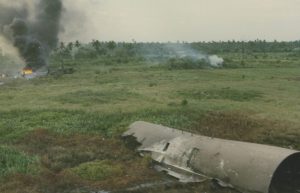 While it was an unusual plan, hatched in the midst of the political fallout, the United States government announced the plan to get thousands of displaced Vietnamese children out of the country. President Ford directed that money from a special foreign aid children’s fund be made available to fly 2,000 South Vietnamese orphans to the United States. Operation Baby Lift lasted for just ten days. Baby Lift was carried out during the final, desperate phase of the war, as North Vietnamese forces closed in on Saigon. Although this first flight ended in tragedy, the rest of the flights were completed safely, and Baby Lift aircraft brought orphans across the Pacific until the mission’s conclusion on April 14, just 16 days before the fall of Saigon and the end of the war.
While it was an unusual plan, hatched in the midst of the political fallout, the United States government announced the plan to get thousands of displaced Vietnamese children out of the country. President Ford directed that money from a special foreign aid children’s fund be made available to fly 2,000 South Vietnamese orphans to the United States. Operation Baby Lift lasted for just ten days. Baby Lift was carried out during the final, desperate phase of the war, as North Vietnamese forces closed in on Saigon. Although this first flight ended in tragedy, the rest of the flights were completed safely, and Baby Lift aircraft brought orphans across the Pacific until the mission’s conclusion on April 14, just 16 days before the fall of Saigon and the end of the war.
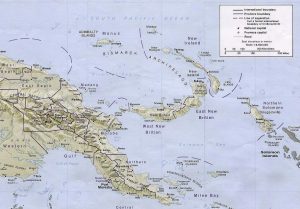 During World War II, the Japanese had a tendency to be very sneaky. Our troops had to watch them very closely, because if they could get into a position to execute a sneak attack, they would do it. Of course, war is war, and the whole idea of war is to get the drop on the enemy, and the Japanese were quite good at it. On 28 February 1943, a convoy, comprised of eight destroyers and eight troop transports with an escort of approximately 100 fighters, set out from Simpson Harbour in Rabaul. On March 1, 1943, United States reconnaissance planes spotted the 16 Japanese ships that were en route to Lae and Salamaua in New Guinea. The Japanese were attempting to keep from losing the island and their garrisons there by sending in 7,000 reinforcements and aircraft fuel and supplies. The Japanese convoy was a result of a Japanese Imperial General Headquarters decision in December 1942 to reinforce their position in the South West Pacific.
During World War II, the Japanese had a tendency to be very sneaky. Our troops had to watch them very closely, because if they could get into a position to execute a sneak attack, they would do it. Of course, war is war, and the whole idea of war is to get the drop on the enemy, and the Japanese were quite good at it. On 28 February 1943, a convoy, comprised of eight destroyers and eight troop transports with an escort of approximately 100 fighters, set out from Simpson Harbour in Rabaul. On March 1, 1943, United States reconnaissance planes spotted the 16 Japanese ships that were en route to Lae and Salamaua in New Guinea. The Japanese were attempting to keep from losing the island and their garrisons there by sending in 7,000 reinforcements and aircraft fuel and supplies. The Japanese convoy was a result of a Japanese Imperial General Headquarters decision in December 1942 to reinforce their position in the South West Pacific.
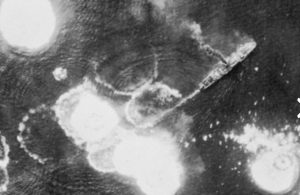 A United States bombing campaign, beginning March 2 and lasting until the March 4, consisting of 137 American bombers supported by United States and Australian fighters, destroyed eight Japanese troop transports and four Japanese destroyers. More than 3,000 Japanese troops and sailors drowned as a consequence, and the supplies sunk with their ships. Of 150 Japanese fighter planes that attempted to engage the American bombers, 102 were shot down. It was a complete and utter disaster for the Japanese. The United States 5th Air Force and the Royal Australian Air Force dropped a total of 213 tons of bombs on the Japanese convoy. The Japanese made no further attempts to reinforce Lae by ship, greatly hindering their ultimately unsuccessful efforts to stop Allied offensives in New Guinea.
A United States bombing campaign, beginning March 2 and lasting until the March 4, consisting of 137 American bombers supported by United States and Australian fighters, destroyed eight Japanese troop transports and four Japanese destroyers. More than 3,000 Japanese troops and sailors drowned as a consequence, and the supplies sunk with their ships. Of 150 Japanese fighter planes that attempted to engage the American bombers, 102 were shot down. It was a complete and utter disaster for the Japanese. The United States 5th Air Force and the Royal Australian Air Force dropped a total of 213 tons of bombs on the Japanese convoy. The Japanese made no further attempts to reinforce Lae by ship, greatly hindering their ultimately unsuccessful efforts to stop Allied offensives in New Guinea.
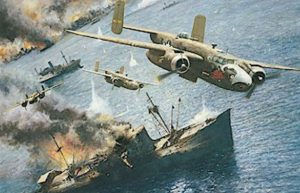
British Prime Minister Winston Churchill chose March 4, the official end of the battle, to congratulate President Franklin D. Roosevelt, since that day was also the 10th anniversary of the president’s first inauguration. “Accept my warmest congratulations on your brilliant victory in the Pacific, which fitly salutes the end of your first 10 years.” President Franklin Roosevelt was one of the very few president who held the office of president for more than two terms…an almost unheard of amount of time, and a recipe for disaster with some presidents we have had. When you think about it, however, what a great way to mark his first inauguration.
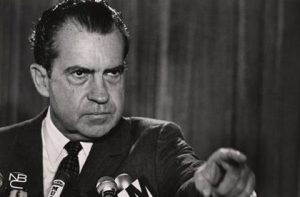 On December 13, 1972, peace talks with North Vietnam broke down, and President Richard Nixon announced that the United States will begin a massive bombing campaign to break the stalemate. Nixon was furious, and order the plans drawn up for retaliatory bombings of North Vietnam, and Linebacker II was the result. The bombings began on December 18, 1972 and continued until December 29, 1972. Beginning with American B-52s and fighter-bombers dropping over 20,000 tons of bombs on the cities of Hanoi and Haiphong. The United States lost 15 of its giant B-52s and 11 other aircraft during the attacks. North Vietnam claimed that over 1,600 civilians were killed. After eleven days of the massive pounding, the North Vietnamese agreed to resume the talks.
On December 13, 1972, peace talks with North Vietnam broke down, and President Richard Nixon announced that the United States will begin a massive bombing campaign to break the stalemate. Nixon was furious, and order the plans drawn up for retaliatory bombings of North Vietnam, and Linebacker II was the result. The bombings began on December 18, 1972 and continued until December 29, 1972. Beginning with American B-52s and fighter-bombers dropping over 20,000 tons of bombs on the cities of Hanoi and Haiphong. The United States lost 15 of its giant B-52s and 11 other aircraft during the attacks. North Vietnam claimed that over 1,600 civilians were killed. After eleven days of the massive pounding, the North Vietnamese agreed to resume the talks.
A few weeks later, the treaty was finally signed and the Vietnam War ended. This also ended the United States’ role in a conflict that seriously damaged the domestic Cold War consensus among the American public. The  impact of the so-called “Christmas Bombings” on the final agreement remains a question. Some historians have argued that the bombings forced the North Vietnamese back to the negotiating table. Others thought that the attacks had little impact, other than the additional death and destruction they caused. Even the chief United States negotiator, Henry Kissinger, was reported to have said, “We bombed the North Vietnamese into accepting our concessions.” The chief impact may have been in convincing America’s South Vietnamese allies, who were highly suspicious of the draft treaty worked out in October 1972, that the United States would not desert them. Despite the forced return to the table, the final treaty did not include any important changes from the October draft.
impact of the so-called “Christmas Bombings” on the final agreement remains a question. Some historians have argued that the bombings forced the North Vietnamese back to the negotiating table. Others thought that the attacks had little impact, other than the additional death and destruction they caused. Even the chief United States negotiator, Henry Kissinger, was reported to have said, “We bombed the North Vietnamese into accepting our concessions.” The chief impact may have been in convincing America’s South Vietnamese allies, who were highly suspicious of the draft treaty worked out in October 1972, that the United States would not desert them. Despite the forced return to the table, the final treaty did not include any important changes from the October draft.
I believe that the bombings were instrumental in bringing the North Vietnamese back to the table, but I sometimes wonder what the emotional impact was on the men involved in the bombings. It’s hard to wage war 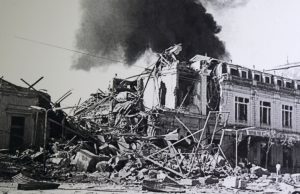 at anytime, but when you think of the Christmas season, and all it stands for, I must have been terribly hard to drop those bombs and end the lives of so many on what should have been a joyous holiday. I’m sure the men thought of their own families and children too. Of course, I don’t know what the North Vietnamese did about Christmas, or if it was anything to them at all, but it was to our men, and it seems to me that it would be very hard to take lives on that day…especially when, in times past it seems like it was common practice to have a cease fire on that day, but then I guess that can’t always be the case. Someone somewhere would insist on breaking the day of peace, because that is what war is all about, after all.
at anytime, but when you think of the Christmas season, and all it stands for, I must have been terribly hard to drop those bombs and end the lives of so many on what should have been a joyous holiday. I’m sure the men thought of their own families and children too. Of course, I don’t know what the North Vietnamese did about Christmas, or if it was anything to them at all, but it was to our men, and it seems to me that it would be very hard to take lives on that day…especially when, in times past it seems like it was common practice to have a cease fire on that day, but then I guess that can’t always be the case. Someone somewhere would insist on breaking the day of peace, because that is what war is all about, after all.
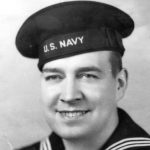 When we think of the name Hitler, most of us think of the vicious dictator who was responsible for the slaughter of as many a 6 million Jewish people, not to mention all the other people he killed in his crazed state of mind. For most of us, hearing the name Hitler brings with it feelings of horror, disgust, and continued shock every time we learn a new fact about Hitler and his Third Reich. Yes, the name Hitler doesn’t usually bring any feelings of…anything good. Well, what I learned today, changed my view of that. You see, not everyone named Hitler was evil, not even everyone named Hitler during World War II, and not even everyone who had the unfortunate…misfortune of being related to Adolf Hitler. You see, for William Patrick Hitler of Liverpool, England, having the name wasn’t the worst part of his situation. William was actually the nephew of Adolf Hitler, the Führer of Nazi Germany. It was a reality that made him almost nauseous. Dealing with that reality would take William on a zigzag path leading to Germany, England, America, and finally the United States Navy. I’m sure that you, like me, thought, “How could the United States Navy allow a nephew of Adolf Hitler to join up, much less to muster out with men sent to fight his uncle.
When we think of the name Hitler, most of us think of the vicious dictator who was responsible for the slaughter of as many a 6 million Jewish people, not to mention all the other people he killed in his crazed state of mind. For most of us, hearing the name Hitler brings with it feelings of horror, disgust, and continued shock every time we learn a new fact about Hitler and his Third Reich. Yes, the name Hitler doesn’t usually bring any feelings of…anything good. Well, what I learned today, changed my view of that. You see, not everyone named Hitler was evil, not even everyone named Hitler during World War II, and not even everyone who had the unfortunate…misfortune of being related to Adolf Hitler. You see, for William Patrick Hitler of Liverpool, England, having the name wasn’t the worst part of his situation. William was actually the nephew of Adolf Hitler, the Führer of Nazi Germany. It was a reality that made him almost nauseous. Dealing with that reality would take William on a zigzag path leading to Germany, England, America, and finally the United States Navy. I’m sure that you, like me, thought, “How could the United States Navy allow a nephew of Adolf Hitler to join up, much less to muster out with men sent to fight his uncle.
Born March 12, 1911, in Liverpool, England, William Hitler was the only child of Bridget Dowling and her Austrian expatriate husband, Alois Hitler Jr, who was the half-brother of Adolf Hitler. In 1914, Alois abandoned his wife and three year old son to go traveling through Europe. The outbreak of World War I prevented him from returning to England, so he settled down in Germany, married again, despite still being married to Dowling, and started a new family. For years, Alois made no attempt to contact his wife and son back in Liverpool, but rather had someone tell Dowling that he was dead. In 1924, the truth came out. Alois was charged with bigamy in Germany, but avoided conviction because Dowling actually interceded on his behalf. That was all she did however. She drew the line, when Alois asked her to send William to Germany for a visit. She told him that she would not let her son visit until he reached his 18th birthday, in 1929. Upon turning 18, William traveled to Germany and reconnected with his father, who took him to a Nazi rally where he saw his Uncle Adolf, leader of the rising National Socialist (Nazi) Party. William visited Germany again in 1930, this time  meeting his uncle in person and receiving an autographed photo from him.
meeting his uncle in person and receiving an autographed photo from him.
I’m sure that William thought that his relationship with his uncle would be something that would advance his journalism career, but Hitler didn’t want anyone to know what he was doing. William’s articles about his Uncle Adolf Hitler, only served to be the beginning of being blackballed from everything to do with Adolf Hitler, and his disgust with Adolf Hitler and his insane ways. Hitler called William to Berlin, and reportedly ordered him to retract the articles. Now William saw a totally different side of his uncle…describing it as a “wild-eyed and tearful” outburst. Apparently Hitler even threatened to kill himself if William ever again published anything about his personal life. Now, William became persona non grata in England. He was fired from his job in 1932. Unable to find other employment in his homeland, he decided to look for work in Germany. Perhaps his increasingly influential uncle could be persuaded to help, but no warm welcome awaited in Germany. According to William, whose July 4, 1939 article for Look magazine, “Why I Hate My Uncle,” is the sole source on his dealings with his uncle Adolf Hitler, who sent William a letter during his visit, denying they were relatives. Shortly afterward, William’s father sent him back to England. I guess he was persona non grata with his dad too.
William tried using his relationship to Hitler to obtain a job in Germany, and was successful, but when he tried to send money to his mother, he was informed that Hitler would not allow it…even for family. William began to see a much more evil side of his uncle. Eventually, he left Germany and went back to England, but found that he was not welcome there either. He and his mother moved to the United States, where his relationship again caused him problems. Finally, in 1942, William wrote directly to President Franklin D. Roosevelt, begging to be allowed to serve in the US military. “I am one of many, but can render service to this great cause,” he wrote. FDR passed the letter on to FBI Director J. Edgar Hoover, who looked into William’s background and finally cleared him for military service. Sworn into the US Navy in New York City on March 6, 1944, William Hitler went on to serve three years as a pharmacist’s mate, receiving the Purple Heart for a wound he suffered. He was 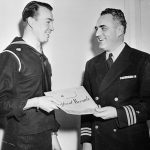 discharged in 1947.
discharged in 1947.
Finally tired of the attention his controversial surname attracted, William changed it to Stuart-Houston after returning to the civilian world. He married German-born Phyllis Jean-Jacques, and the couple settled in Patchogue on New York’s Long Island, where they had four children, the first of whom bore the surprising middle name of Adolf. William ran a blood analysis lab, Brookhaven Laboratories, in his family’s home. William Stuart-Houston died on July 14, 1987, and was buried next to his late mother in Coram, New York. His children did not produce any children of their own…and so ended the line.
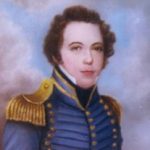
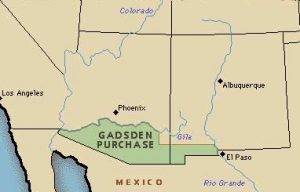 Most people have an idea in their head about what the continental United States looks like, but it was almost slightly different than it is now. The United States acquired the bulk of the southwestern corner of the nation from Mexico in 1848 as victors’ spoil after the Mexican War. However, congressional leaders who were eager to begin construction of a southern railroad, wanted to push the border farther to the south. The government directed James Gadsden, the American minister to Mexico, to negotiate the purchase of an additional 29,000 square miles. If you’re like me, you might be wondering what was so important about those 29,000 square miles. It’s a very small section, compared to other land purchases made by the United States, after all. Yet, this little piece of land was very important to the government. The purchase included lands south of the Gila River and west of the Rio Grande which the United States acquired so that it could construct a transcontinental railroad along a deep southern route, which the Southern Pacific Railroad completed in 1881/1883.
Most people have an idea in their head about what the continental United States looks like, but it was almost slightly different than it is now. The United States acquired the bulk of the southwestern corner of the nation from Mexico in 1848 as victors’ spoil after the Mexican War. However, congressional leaders who were eager to begin construction of a southern railroad, wanted to push the border farther to the south. The government directed James Gadsden, the American minister to Mexico, to negotiate the purchase of an additional 29,000 square miles. If you’re like me, you might be wondering what was so important about those 29,000 square miles. It’s a very small section, compared to other land purchases made by the United States, after all. Yet, this little piece of land was very important to the government. The purchase included lands south of the Gila River and west of the Rio Grande which the United States acquired so that it could construct a transcontinental railroad along a deep southern route, which the Southern Pacific Railroad completed in 1881/1883.
The purchase might not have been possible, were it not for the fact that the Mexican ruler, Santa Ana was eager to do business with the United States…despite having been badly beaten in war only five years earlier and forced to cede huge tracts of land to the victorious Americans. Santa Ana had only recently regained power, and he was in danger of losing office, unless he could quickly find funds to replenish his nearly bankrupt nation. Gadsden and Santa Ana agreed that the narrow strip of southwestern desert land was worth $10 million. When the treaty was signed on December 30, 1853, it became the last addition of territory…other than the purchase of Alaska in 1867…to the continental United States. The purchase also completed the boundaries of the American West.
In order to secure the area, the government established Fort Buchanan. It was also set up to protect emigrants traveling through the new territory from the Apache Indians, who were strongly resisting Anglo incursions, which they considered to be intrusive. With the outbreak of the Civil War four years later, northern politicians abandoned the idea of a southern line in favor of a northern route that eventually became the Union Pacific line, but the idea of a southern line remained…under the surface, but there nevertheless. It would take a number of years for that idea to become a reality, but since it did happen, I guess the original purpose for the purchase was honored after all.
On this day November 17, 1856, the United States founded Fort Buchanan, named after President James Buchanan three miles southwest of present-day Sonoita in Santa Cruz County, Arizona on the east slope of what is now called Hog Canyon. At the time, the area was under constant threat from hostile Apaches. Full-scale war with the local Chiricahua Apache was initiated by the Bascom affair in early 1861, during which 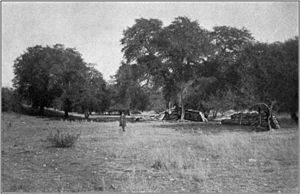
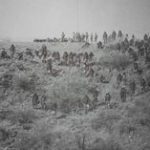 Lieutenant George Nicholas Bascom and his patrol were based at Fort Buchanan. The fort was officially abandoned in 1861, though troops of the California Column occasionally manned the post during the American Civil War. In February 1865, Apaches attacked and burned the fort in the Battle of Fort Buchanan, forcing the small garrison to retreat. It was then abandoned for good and Fort Crittenden was established half a mile east on the flats in 1867. Sadly, Fort Buchanan was never rebuilt.
Lieutenant George Nicholas Bascom and his patrol were based at Fort Buchanan. The fort was officially abandoned in 1861, though troops of the California Column occasionally manned the post during the American Civil War. In February 1865, Apaches attacked and burned the fort in the Battle of Fort Buchanan, forcing the small garrison to retreat. It was then abandoned for good and Fort Crittenden was established half a mile east on the flats in 1867. Sadly, Fort Buchanan was never rebuilt.
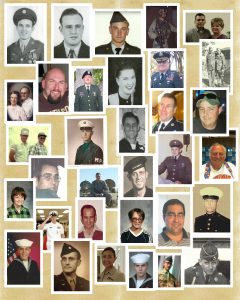 In a time when our nation is in such turmoil, I find myself appreciating our veterans even more than I did before. As a proud daughter of a World War II veteran, I always had a feeling of awe when it came to the members of our military. I never thought of a soldier without associating it with a hero, because that is what they are…each and every one of them. It takes the heart of a hero to set aside their own life, time with family, and their safety to protect the rights and lives of others…people they don’t know…who aren’t in their own country.
In a time when our nation is in such turmoil, I find myself appreciating our veterans even more than I did before. As a proud daughter of a World War II veteran, I always had a feeling of awe when it came to the members of our military. I never thought of a soldier without associating it with a hero, because that is what they are…each and every one of them. It takes the heart of a hero to set aside their own life, time with family, and their safety to protect the rights and lives of others…people they don’t know…who aren’t in their own country.
Soldiers are a special kind of hero. Like our first responders, they run into danger while others are running away, but a soldier does that in countries that aren’t their own. They have no stake in that country, but they know that without their help, the people of that nation are going to continue to live oppressed. The soldier fights for those who cannot fight for themselves. Evil dictators cringe when the soldiers are sent in, because there is a good possibility that the dictator’s days are numbered. War is never an easy journey for the soldier, but he or she knows that they are needed. They know that for every enemy death…a life is saved, and while that may be putting things a little bit simplistically, in a very real sense, it is true. In a war, the enemy must be beaten, in order to win the war, and thereby save the innocent.
Going off to war changes a person, and so does training to go to war. The minute a soldier joins up, there is a possibility of going to war, and the soldier has to face that fact. That’s where the heart of the hero kicks in. Deep down inside, the soldier has knows that what they are doing is important…it matters. Theirs is often a thankless job, and is sometimes treated with great disrespect, but when they are needed, they answer the call, nevertheless. It is our soldiers and their strength, that usually keeps our homeland free from attack. It’s not that we have never had attacks on our soil, but a strong, at the ready military force, makes our enemies think twice about trying to attack us here…and for that, I thank our military men and women. Our nation is very blessed to have our soldiers. To our active duty soldiers and our veterans of all wars, Happy Veterans Day!!
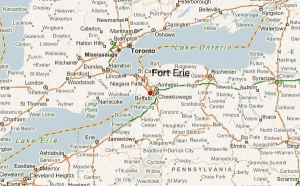
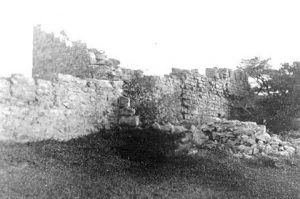 Part of the War of 1812 involved a border dispute between the United States and British North America, which is present-day Canada. During the war, the Americans launched several invasions into Upper Canada, at the point of present-day Ontario. One section of the border where this was easiest, because of communications and locally available supplies, was along the Niagara River. Fort Erie was the British post at the head of the river, near its source in Lake Erie. In 1812, two American attempts to capture Fort Erie were bungled by Brigadier General Alexander Smyth. Bad weather or poor administration halted the American efforts to cross the river, and Fort Erie remained in British hands.
Part of the War of 1812 involved a border dispute between the United States and British North America, which is present-day Canada. During the war, the Americans launched several invasions into Upper Canada, at the point of present-day Ontario. One section of the border where this was easiest, because of communications and locally available supplies, was along the Niagara River. Fort Erie was the British post at the head of the river, near its source in Lake Erie. In 1812, two American attempts to capture Fort Erie were bungled by Brigadier General Alexander Smyth. Bad weather or poor administration halted the American efforts to cross the river, and Fort Erie remained in British hands.
In 1813, the Americans won the Battle of Fort George at the northern end of the Niagara River. At this point, the British abandoned the Niagara frontier and allowed Fort Erie to fall into American hands without a fight. Unfortunately, the Americans failed to follow up their victory, and later in the year they withdrew most of their soldiers from the Niagara to furnish an ill-fated attack on Montreal. This allowed the British to recover their prior positions and to mount raids which led to the Capture of Fort Niagara and the devastation of large parts of the American side of the Niagara River.
For 1814, a new invasion of Upper Canada was planned under the command of Major General Jacob Brown. Originally aimed at Kingston on Lake Ontario, it was switched to the Niagara because British ships controlled Lake Ontario for the first six months of 1814. The United States finally captured Fort Erie in 1814. It was thought that the British, while outnumbered, surrendered Fort Erie prematurely…at least in the view of the British commanders. They fully expected the outnumbered British troops to stand and fight…to the death, if need be. Because American troops were already concentrated at Buffalo and Black Rock, the attack was to be launched across the southern part of the Niagara frontier. Fort Erie was the first objective that stood in the way, and so, its capture was required. Lieutenant General Gordon Drummond, the British commander in Upper Canada, hoped that the garrison at Fort Erie could at least buy him enough time against the American invasion to concentrate his forces. Major Thomas Buck was given command of the fort with a garrison of 137 British soldiers.
Brown’s force crossed into Canada on July 3, 1814. Brigadier General Winfield Scott landed a mile and a half north of the fort with a brigade of regulars while it was still dark. Another brigade under Eleazar Wheelock Ripley crossed the head of the river to the south of the fort, a little behind schedule due to fog. Meanwhile, New York militia demonstrated opposite Chippewa to distract the British troops in the area. As Scott’s and Ripley’s forces approached Fort Erie, Buck fired only a few shots at the Americans from the fort’s cannon and then surrendered. The Americans had captured an important fort at little cost. The fort’s garrison had bought the British very little time and Buck was later court martialed for his hasty surrender.
From their new base at Fort Erie, Brown next marched up the Niagara River and met the British at the Battle of Chippewa. The British commander at Chippewa, Major General Phineas Riall, believed that the garrison of Fort Erie was still holding out, which contributed to his decision to launch a hasty and ill-fated attack. Following the Battle of Lundy’s Lane in July, British forces under the command of Gordon Drummond advanced and unsuccessfully attempted to besiege the fort. After that it remained in American hands until the American commanders decided to abandon the fort, which was evacuated and blown up in November 1814. These days, with so many historic forts across the nation, it was shocking to me to read that they had blown up the fort, 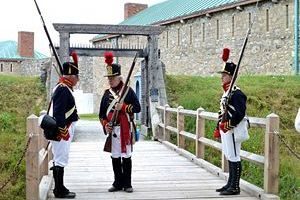
 but I guess they weren’t interested in the historic side of things…they were making history. The fort, which had been built by the British in 1764, was restored, and was incorporated as a village in 1857. It became a town when it merged with Bridgeburg in 1932. Fort Erie is now the site of a large horse-racing track and has steel, aircraft, automotive, paint, and pharmaceutical industries. It is a town with a population of 29,960 in 2011.
but I guess they weren’t interested in the historic side of things…they were making history. The fort, which had been built by the British in 1764, was restored, and was incorporated as a village in 1857. It became a town when it merged with Bridgeburg in 1932. Fort Erie is now the site of a large horse-racing track and has steel, aircraft, automotive, paint, and pharmaceutical industries. It is a town with a population of 29,960 in 2011.

